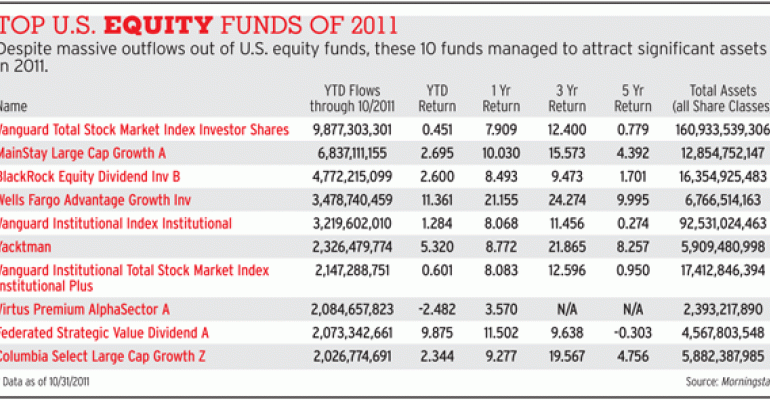For the last couple years, retail investors have been skittish about U.S. equity mutual funds, to say the least, redeeming some $74.5 billion from these funds year to date through November 2011 and nearly $75 billion in 2010. But a look at the top 10 U.S. equity funds shows that some dividend and income-producing funds, high performing funds, and a few legacy winners were able to buck the trend.
At the top of the list, the Vanguard Total Stock Market Index Investor Shares (ticker: VTSMX) brought in about $9.9 billion in assets for January through October 2011. The funds that took in the second and third highest levels of assets through October included the MainStay Large Cap Growth Fund (ticker: MLAAX), with $6.8 billion in new assets, and the BlackRock Equity Dividend Investor B (ticker: MBDVX), with about $4.8 billion in new assets through October.
The list of top asset winners (below) includes a few dividend- or income-producing funds, including the BlackRock Equity Dividend Investor B, the Yacktman Fund (ticker: YACKX), and the Federated Strategic Value Dividend A (ticker: SVAAX). Dividend-paying stocks have been a popular investment during the recent market volatility because of the yields these stocks offer.
“[Investors] tend to gravitate toward income-producing funds in times of uncertainty or greater volatility, because at least you can depend on a somewhat steady stream of income,” said Jeff Tjornehoj, head of Lipper Americas research. “Generally speaking, good income producers had the advantage the past few years, and the larger the fund the more marketing dollars that can be deployed to keep the fund front-and-center in the eyes of advisors and investors.”
The largest funds on this list, those with the most total assets and presumably the most marketing dollars, include the Vanguard Total Stock Market Index Fund, with total assets of $160.9 billion as of October 2011; the Vanguard Institutional Index Fund (ticker: VINIX), with about $92.5 billion in total assets; and the Vanguard Institutional Total Stock Market Index Institutional Plus (ticker: VITPX), with about $17 billion in total assets. The BlackRock fund had about $16 billion in total assets as of October.

“Big funds attract big money; they also lose big money,” Tjornehoj said. Case in point: The Fairholme Fund (ticker: FAIRX) brought in $256 million in 2010, but had an outflow of about $5.4 billion in 2011 (year-to-date through October).
The Vanguard funds are so large and have economies of scale, so they can afford to be cheaper, Tjornehoj said. Investors haven’t forgotten how important expenses can be to their long-term success.
In addition, the Vanguard Total Stock Market funds offer broad exposure to the stock market, an advantage for do-it-yourself investors, Tjornehoj said. “It’s always going to be a great place for broad exposure and low cost,” he said. “I can’t see anybody taking that mantle from them.”
According to Stan Luxenburg, Registered Rep.’s mutual fund writer, these Vanguard funds are more tax efficient than an S&P 500 fund. “The total market funds have done better in recent years because they hold some small stocks,” he said. “But if large caps come back in favor, then the S&P 500 funds will outdo the total market funds.”
But there were some large-cap equity funds too in the mix here, which Tjornehoj says could be a contrarian move. Others might believe the market has reached a bottom, so they’re trying to get into a more aggressive fund to ride it up, he added.
There are also some legacy winners on the list, or those funds that have been gathering a lot of assets over the last couple years. For example, the Vanguard Institutional Index Fund and the BlackRock Equity Dividend Fund were both in the top 10 winners for 2009 and 2010, while the Vanguard Total Stock Market Index Fund took in the most assets in 2009.
These legacy winners may have good long-term track records, or they may have good stories to tell. “If you’re fund has been woefully unsuccessful, it’s hard to create a good story for your marketing team,” Tjornehoj said.
That said, some would simply chalk up these fund flows to good performance. These funds had particularly good one- and three-year total returns (see chart below).
“The truism in the fund industry, or investment community, is that flow follows performance,” said Charles Biderman, founder and CEO of TrimTabs Investment Research. “Always has, always will. An area someone consistently makes money, people will invest in that.”
“It’s tough to stand by a bottom performer,” Tjornehoj said. “Look what happened to Legg Mason Value Trust. It’s just a husk of its former self as far as assets go.”
But Tjornehoj doesn’t believe having the top performance is a guarantee of bringing in a lot of assets. “You still have to get your message out there. It’s not as rational as many would like to believe.”






